Series Retrospective: The Bowery Boys
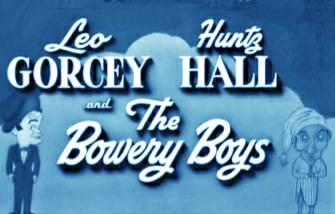
The Bowery Boys Logo
In the pop culture trinity of theatrical properties that achieved greater success on television, the Three Stooges and the Little Rascals will always be firmly situated in the first two positions. The third and perhaps more disputed spire will, in my mind, always belong to the Bowery Boys. Unlike the Stooges and the Rascals which were theatrical shorts with each installment usually running around twenty minutes, the Bowery Boys series were technically feature films. I say technically because the films usually clocked in at about sixty-five minutes each which just barely qualified them as features and also made them more difficult to program in television time slots. Where the short subjects could be paired up with cartoons, live host segments, and other shorts into all manner of thirty minute and one hour programs, the Bowery Boys films were usually limited to ninety minute movie slots and even then required some kind of additional padding since commercial time was restricted when they were first sold into syndication. This made the film series less well known than the Stooges or the Rascals but anyone lucky enough to catch them was in for a good time.
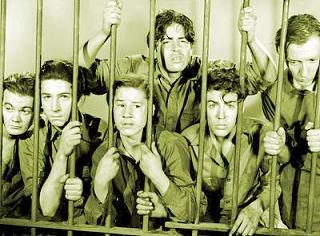
The Bowery Boys began life as the darker toned Dead End Kids
The Bowery Boys actually began life a full decade before they would ever use that moniker in Sidney Kingsley’s 1935 Broadway play Dead End which concerned a gang of youths growing up in the inhospitable slums of New York City. This group of street wise punks was referred to, appropriately enough, as the Dead End Kids and counted among its ranks aspiring actors like Leo Gorcey and his brother David, Huntz Hall, Bobby Jordan, Billy Hallop, and Gabriel Dell. MGM made the play into a successful movie two years later and retained most of the original cast which they then carried over into their own film series. Universal got into the act a year later and rounded up some of the kids MGM had passed over to create there own juvenile gang series called the Little Tough Guys which lasted for five years. Monogram Pictures, a lower tier studio known for micro budget exploitation films, jumped on the band wagon a short time later with a series called the East Side Kids that outlasted the others and eventually featured almost all of the original young actors from Dead End.
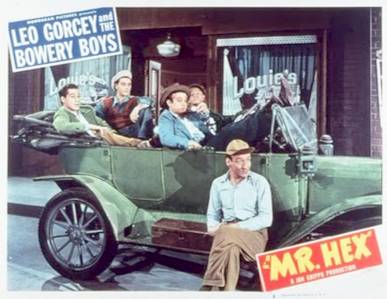
A lobby card from the early Bowery Boys entry Mr. Hex
The East Side Kids proved extremely popular with audiences and Leo Gorcey slowly rose through the ranks as the leader of the group with Huntz Hall along as his goofball sidekick. When Gorcey’s contract came up for renewal in 1945 and the studio refused his salary demands, he and Hall partnered up with agent Jan Grippo to replace the East Side Kids with their own series, the Bowery Boys. Monogram was reluctant to lose the series entirely and signed on to distribute the Bowery Boys movies. While other studios still attempted to produce similar films, most were lost in the shuffle and after a few years almost all of them gave up trying to imitate the formula Gorcey and Hall had perfected into an art form.
The Bowery Boys premiered in 1946 with their first film, Live Wires. This incarnation of the gang featured Leo Gorcey as their undisputed leader, Terrence Aloysius “Slip” Mahoney, Huntz Hall as his bird brained second in command Horace Debussy “Sach” Jones, David Gorcey (usually billed under his mother’s maiden name of Condon) as Chuck, and Billy Benedict as the fair haired Whitey. Other members would include Bobby Jordan, Bennie Bartlett, Buddy Gorman and Gabriel Dell who usually played the boys’ older friend and liaison to the adult world. While very little was seen or mentioned about the boys’ families or lives outside of the group, they were given a regular hang out called Louie’s Sweet Shop run by the only adult they seemed to be able to trust, Bernard Gorcey (Leo and David’s father).
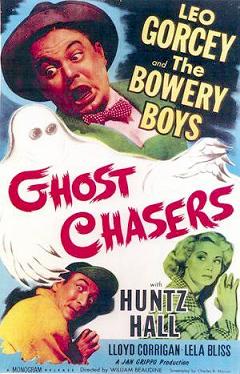
The poster for one of several haunted house themed Bowery Boys films
For most films in the series, Slip and Sach were at the forefront of the group and always given the most to do on screen. The fact that Leo Gorcey was producing the series and both he and Huntz Hall contributed to the scripts probably didn’t hurt. Where the Eastside Kids and other groups before them had clearly been juvenile delinquents sometimes bordering on criminal behavior, the Bowery Boys were good natured slackers whose intentions were never less than honorable. Typically the boys would get into trouble while attempting to do a good deed and then spend the remainder of the story trying to exonerate themselves and/or apprehend the guilty party. In the third film, Bowery Bombshell, for example, the boys are mistaken for bank robbers while trying to raise $300 to help out Louie. Slip pretends to be a gangster to fool the real crooks into revealing themselves. Things don’t go quite as planned but after a few comic mishaps everything turns out all right in the end. The stories were repetitious and weren’t that original to begin with but with the studio producing as many as five films in one year there wasn’t much time for complicated plotlines.
Gorcey and Hall quickly fine tuned their comedy routines and settled into a pattern with Slip being the overconfident leader who was never as smart as thought he was while Hall portrayed the loveable clown who was always just a little smarter than anyone gave him credit for. Gorcey tended to rely more on verbal humor such as murdering the English language on an almost continual basis and making up words when he couldn’t think of a suitable one but he wasn’t beyond smacking Sach with his hat when the need arose. Hall on the other preferred to make faces at the camera, gesture with his hands, vibrate his lips like a motorboat, and commit the occasional pratfall in the name of laughs. The chemistry between the two leads was dynamite but it usually left very little for the rest of the gang to do other than deliver information to advance the story or get kidnapped by the villain of the week. This lead to a number of character changes among the background members over the years with only David Gorcey, not surprisingly, surviving until the end of series.
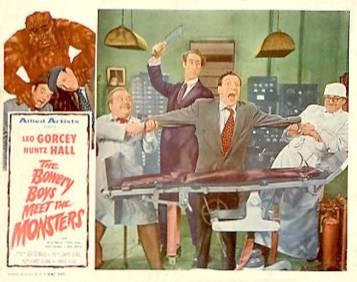
It just had to happen! The Bowery Boys Meet the Monsters!
Between 1946 and 1956, the Bowery Boys turned out an amazing forty-one feature films. During this time they fought spies, con men, gangsters, and hillbillies, temporarily joined every branch of the armed forces at least once, and traveled to France, England, the Middle East, and even darkest Africa! In 1953, Monogram decided the financial obligations of distributing the series were too much but Allied Artists, who had missed out on the profits from these youth oriented pictures up to this point, quickly jumped in to take their place. The series reached its peak in 1954 with the not so subtly titled The Bowery Boys Meet the Monsters. In typical Bowery Boys fashion, Slip and Sach travel to a remote estate to locate the owners of a vacant lot they want to turn into a community baseball field. It turns out the Gravesend family are all psychopaths of one variety or another including one member who might really be a vampire. Sach ends up in a tug of war between two battling brothers competing to see if his brain will go in a robot or a gorilla and he eventually turns into a Mr. Hyde like monster. Louie and the rest of the gang come looking for them and one chase after another ensues. It wasn’t Abbot and Costello Meet Frankenstein (Bela Lugosi has previously appeared in two Eastside Kids films and is sorely missed here) but the laughs still hold up today.
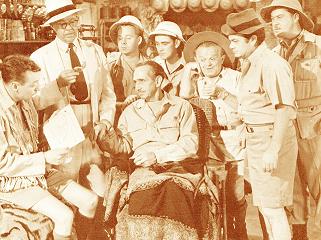
The Bowery Boys travel to darkest Africa in Jungle Gents
The Bowery Boys series hit a major snag in 1956. Following the completion of Dig That Uranium, Bernard Gorcey was killed in a car accident. His death came as a major blow to son Leo who began drinking more heavily than usual. He became unreliable and hostile during the filming of the next film, Crashing Las Vegas, and quit the series after losing a show down with the studio. Allied Artists was faced with a tough decision, the Bowery Boys movies were still popular with the public and the other actors were under contract for three more films that had already been promised to distributors but Gorcey was a critical component of what made the movies work.
To fulfill their contractual obligations, Allied Artists rightfully promoted Huntz Hall to top banana (the film credits now read Huntz Hall and the Bowery Boys) and brought Stanley Clements in to play Sach’s new foil, Stanislaus “Duke” Coveleskie. In recognition of the fact that the Bowery Boys weren’t exactly “boys” any longer, their characters were upgraded to acting slightly more like adults. They were shown to all live together in the same boarding house and they now hung around a greasy spoon called Mike Clancy’s Café which bore a striking resemblance to Louie’s Sweet Shop with a different actor behind the counter.
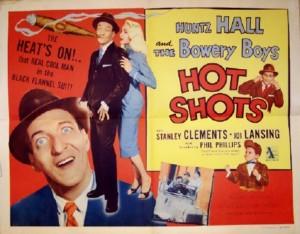
Huntz Hall and Stanley Clements in 1957's Hot Shots!
Stanley Clements did an admirable job in the Leo Gorcey role, keeping the overall flavor of the character the same while still adding enough of his own touches to make it unique. Huntz Hall’s Sach became less of a buffoon and more of a wise guy in these films but the group dynamic was still enjoyable. The background boys, usually Chuck, Butch and later Eddie Leroy as the bespectacled Blinky, were actually given a little more dialog and screen time in these later films to help smooth over Leo Gorcey’s absence. Allied Artists was so pleased with the revisions that they renewed the series for five more installments in 1957.
The first three Hall/Clements films had largely been rehashes of previous plots designed to end the series on a familiar note and shock the fans as little as possible over Leo Gorcey’s departure. The final five movies attempted to take the series off into new directions and featured some interesting stories that provided the group with some, at least mildly, fresh situations. Spook Chasers trotted out the old haunted house clichés only this time with a real ghost added into the mix. Looking for Danger is the only Bowery Boys’ movie that is entirely fantasy as the story turns out to be a tall tale fabricated by Duke but he and Sach get to lampoon the US military, Arab sheiks and Nazis all in the same movie. Many years before Cheech and Chong, the Bowery Boys went Up in Smoke when Sach makes a deal with an underling devil (played hilariously by Byron Folger) that ends up getting both of them in big trouble. The final film, In the Money, took the boys back to England and pitted them against diamond smugglers in a loose amalgamation of previous stories that focused on Sach and was still very entertaining.
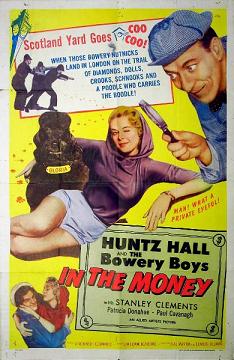
The poster for final Bowery Boys film In the Money released in 1958
By the time In the Money was released in 1958, lead actor Huntz Hall was pushing 40 and hardly a boy any more. He was also growing tired of having spent over twenty year of his life playing juvenile delinquents and clowns even if it did pay well. He decided to call it quits and Allied Artists wisely decided to let the series go with him while it was still ahead. In the end, the Bowery Boys had made 48 films, more than any other series in history before or since, and in only twelve years! This made the syndication package extremely attractive to television stations where the films spent the better part of the next two decades usually occupying the late night and early morning hours when programming schedules were more flexible. The series was also a popular staple of movie theaters’ kiddie matinee shows all throughout the 60’s and 70’s. Unfortunately these films have never been released on home video and sorely deserve a collector’s edition boxed set to get them out to anyone who appreciates classic comedy
